Magazine: The Aqua Portrait of Marius Schumann
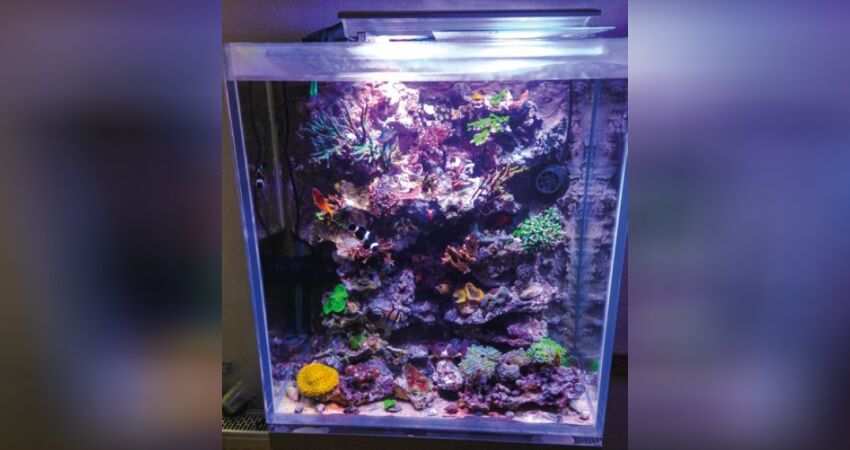
from issue 02 of Korallenriff Magain: Aquaristics has shaped me for almost my entire life. After I started "keeping" native sticklebacks at the age of five,
I got my first 60-litre freshwater aquarium as a present at the age of seven. This was followed in 2010, at the age of 14, by a Sera - 130l - marine aquarium, which I took over already "run-in"
Since that time, the salt in the soup never left me.
Quickly a second 80 - litre tank followed and later some more external aquariums in which I worked scientifically with Odontodactylus scyllarus (clown mantis shrimp) on colour-bound communication. Of course, an aquarium could not be missing in the student flat. When planning the aquarium, I decided to build something unusual. Since the chosen location only allowed for a width of 60 cm and Leipzig's old building is not exactly known for its suitability for aquariums, I decided to design another small aquarium. In this tank, my fascination for mantis shrimps was to meet the visual component of a colourful reef aquarium. To get as much decorative surface as possible despite the small footprint, I decided on a high dimension (65x60x35 HxWxD) and a volume of about 130l. For the glass, I chose white glass 12 mm thick, which was glued transparently and could be illuminated from behind with LED strips. In addition, I purchased a 20 mm thick acrylic plate, polished at the edges, as a base on which the basin floats, so to speak.
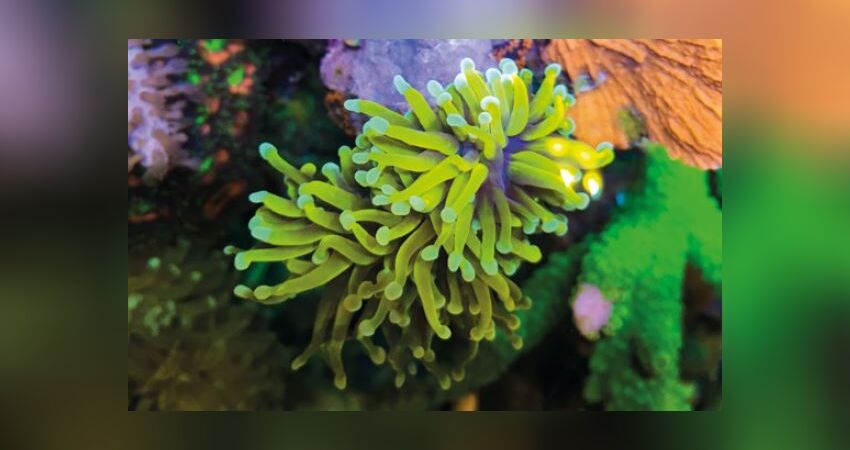
I was now faced with the question of suitable technology and decoration. I planned to make the aquarium as simple as possible. For this reason, I ordered a custom-made ceramic back wall, which had an integrated filter chamber for a small skimmer, heater, filter wadding and some carbon, adsorber etc.. I equipped the chamber with a small 1200l pump, which pushes the water out of the chamber via a small hole, thus forming an overflow into this technical chamber. I drilled holes in the back wall for the flow pumps so that they did not have to be mounted on the side of the glass.
The beginning proved to be a bit hairy. I knew that the large ceramic mass, calculated on the small water volume, would inevitably lead to strong KH fluctuations and the release of harmful substances. To counteract this, I decided to run the aquarium with tap water for four weeks and to add one tablespoon of sodium hydrogen carbonate to the tank every day during this time. Every five days I changed the water and added carbonate again. In this way, I made sure to saturate the ceramic with carbonates in such a way that the expected KH fluctuations were effectively counteracted. I then added live stones, which I glued dry, and filled the aquarium with seawater.
Because I had good experience with the run-in method via a bacterial bloom, I overdosed three different bacterial products every day. From a biological point of view, it makes sense to use one product with mud bacteria and one with nitrogen bacteria. To get the bacteria growing, as it were, I dosed 2 ml of vodka every day. It is not necessary to name an exact product at this point, as all products on the market have a very similar effect here. I did not measure the butt4 - value, as I assumed that the bacterial bloom would dissolve all deposits from the rock. After a week, I removed the milky water and replaced it with natural seawater.

In current operation, I completely refrain from dosing bacteria, as they interfere too much with the general pool biology for me and can also dissolve heavy metals such as copper from the live rock. This copper increase was clearly measurable during the run-in phase. At this point, I would like to briefly explain this run-in method in more detail. Live rock binds different ions to different degrees. Positively charged metal ions (e.g. copper or iron) are bound particularly strongly. This is also called cation sorption. Bacteria release various acids/acid residues (positively charged) and also hydrogen protons (H+) via their metabolism. This leads to a physiological acidification of the rock. In this acidic environment, in which a lot of H+ in the form of the hydronium ion (H3O+) is present, the binding capacity of positively charged matallions decreases. These are then released into the free water. At the same time, the bacteria break down calcium phosphate (depots). However, this can also lead to a massive Po4 - increase in the free water and should therefore, in my opinion, be avoided during operation. By the way, pure ceramic tanks often have a problem with the settlement of bacteria, as the alkaline pH value of the ceramic opposes the natural acid environment of the bacteria. This leads to fluctuations in the water parameters. Even a highly porous ceramic therefore often offers much less settlement space in the first period than is often assumed. For this reason, I switched to a pH neutral artificial rock for another quick start. But I will come to that later.
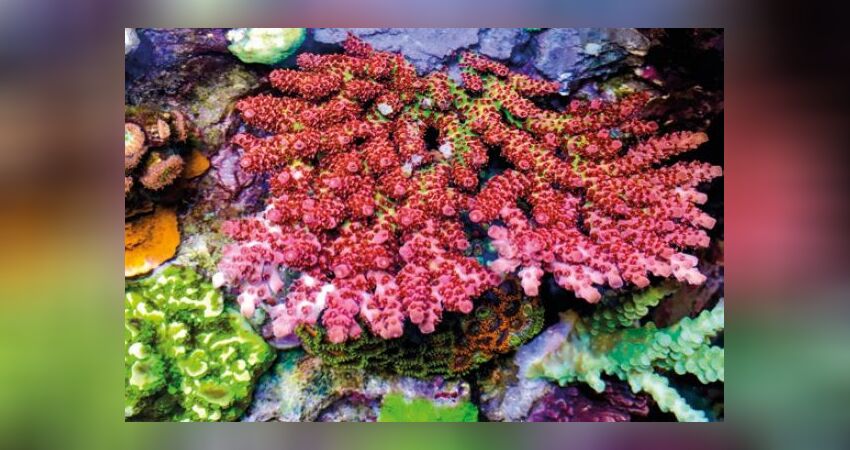
Unfortunately, a very long-lasting shortage of mantis shrimp resulted. For months, despite good contacts, I was unable to order a single animal, which is why I decided to keep fish after all. Only German brands were used for the equipment. But the flow pumps caused considerable problems. They were noisy, stopped and were very limited in the choice of different modes. After sending the pump back to the manufacturer for the third time, I decided to temporarily use a pump from a Chinese manufacturer. Since then, I have only used these pumps. My old pump, which is actually new, is still with the manufacturer to this day and, I hope, enjoying its well-deserved retirement.
The tank developed very well over the next few months. After some time I also added Torch corals (Euphyllia glabrescens), which formed 12-15 polyps each from two within half a year. I put this down to the very white-heavy setting of my LED and the daily feeding with Artemia. Unfortunately, the light was not quite optimal for the SPS, which was especially evident in the colouration. The tank was operated with the Triton method at this time. As the system recommended a refugium, I installed a vortex filter with circulating LED and connected it to the tank by means of hoses and a pump. However, cleaning the algae was a bit tedious, which is why I would not recommend this procedure. I also had to add quite a few trace elements by hand.
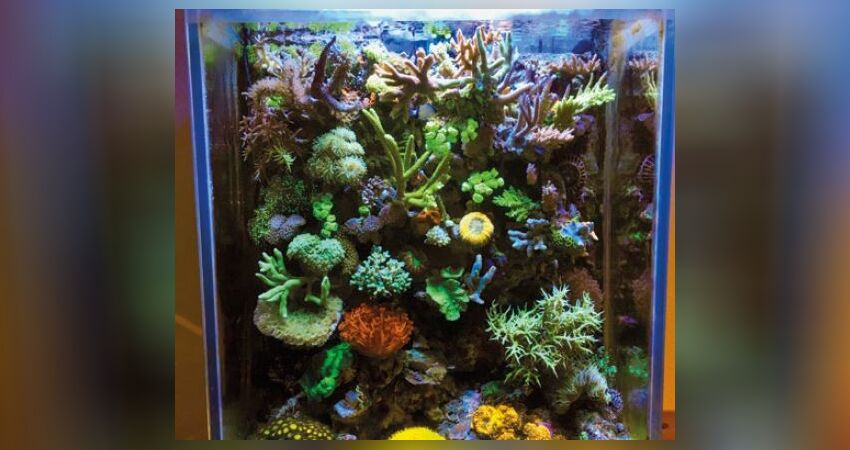
Unfortunately, it turned out that the wire algae I had purchased were contaminated with Oodinum spores or some other coral fish disease that I unfortunately could not specify, which sent all my fish stock to the eternal hunting grounds. After this severe setback, the tank continued to develop well. I had also acquired a red starfish due to the good availability of biomass. The corals continued to grow and soon it became necessary to move some of the larger sticks with reef cement.
Because my usual mortar was not available, I switched to an alternative manufacturer on the advice of a specialist shop. Contrary to my expectations, however, this powdered in the aquarium. After a big wash, I thought the animals were safe. Unfortunately, my starfish must have taken some of this dust into its ambulacral space and died the next day, probably due to the drastic pH change inside its body. Unfortunately I was not present at the time and to my regret the animal died with a good view right on top of a flow pump, which cleaned the body of all tissue and distributed it in the aquarium. Whether it was due to possible toxins or simply to the abrupt changes in nutritional value, I still can't say for sure. Unfortunately, however, my large Acropora tumida and subsequently all the other corals were stimulated into massive slime production. When I returned home in the evening, I was already surprised by a foul smell on the ground floor. This made me think that a fish truck, which had survived a full closure of the A1 for several days in the summer, had driven straight into the house. But all joking aside. The stench was really immense and, to my horror, increased noticeably on the way to my flat. Opening the door almost took my breath away. A look inside the aquarium revealed that the corals had produced so much slime that they had suffocated each other. Despite several total water changes, 90% of the corals were dead within the next two days. The Po4 - values were so high that all tests showed only a deep blue above the scale.
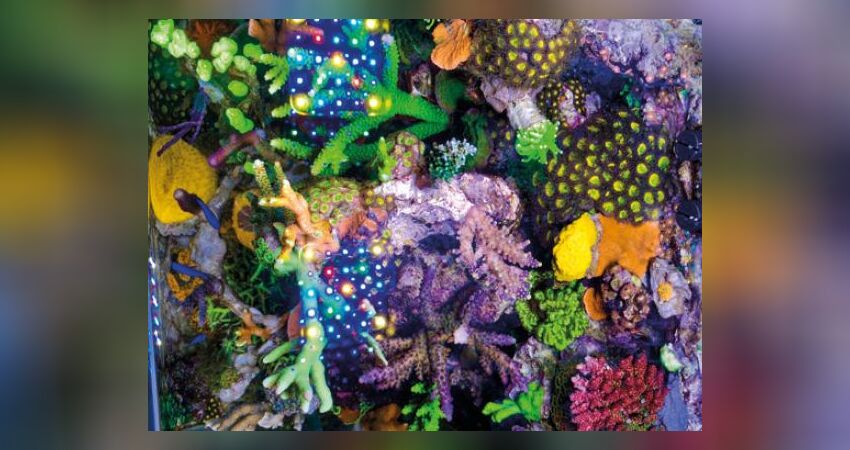
Within the next few weeks, I thought about quitting several times. But in the end, love for the hobby won out. After I had disposed of all the rocks, the back wall, which was firmly glued to the tank, proved to be a real disadvantage. Over eight weeks I carried out one bacteria cure after the other in overdose. Fortunately, I was able to keep the few remaining corals with friends. Although the values in the open water quickly returned to normal, large amounts of calcium phosphate had formed in the back wall, which provided an excellent breeding ground for bryopsis algae. These can effectively split calcium phosphate and therefore survive even with NN values of phosphorus. To make life more difficult for the algae, I operated the light only on the UV channel and added a litre of phosphate adsorber. After weeks, the algae finally gave up.
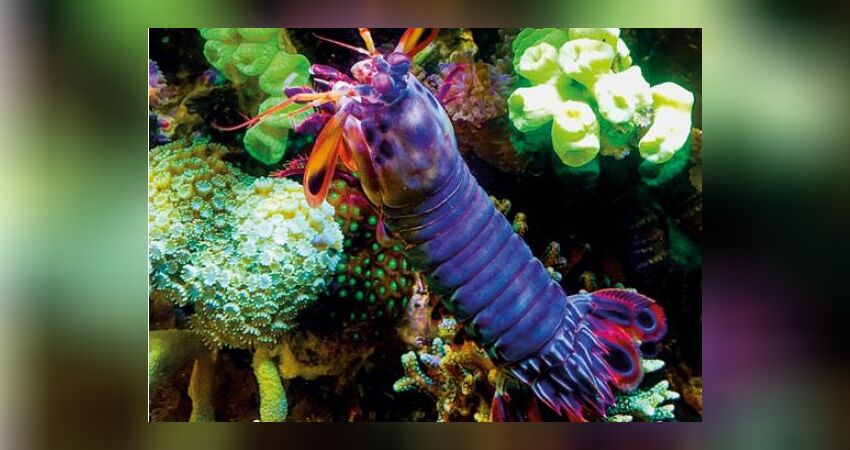
I am using the fresh start to switch to a new supply system, the ATI - Essentials Pro. Due to the space I had in the base cabinet, this proved to be an immense advantage, as the two containers need to be refilled correspondingly less often than the four I had previously used. I also decided to go for 100% offspring for corals. Since then, the aquarium has been developing excellently again. The growth and colouring of the corals have increased noticeably and the water values remain very constant. A female clown mantis shrimp was also able to move in. For decoration I used a little live rock and especially the pH-neutral EpoReef, which I also used to build the cave for the crab. I did not use ceramics to save on the carbonate cure and to accelerate the colonisation with bacteria and thus the "settling in". In September 2019, I switched the lighting to Jebao AL 150 LED and have been much happier with the light ever since. The aquarium is run very simply, just via the Essentials Pro I mentioned and supplemented with the ATI - Nutritions. I use these to be able to do without an increased fish stocking and thus bring in less detritus. This gives me crystal-clear water and optimal conditions for the corals, even without a large filter. The use of soda lime in front of the skimmer has also proved to be a real advantage, as it has boosted growth considerably. I also do a small water change with Absolut Ocean salt every three weeks. In my experience, this is the best for my corals of all the salts I have tested so far. It wouldn't really be necessary to do these water changes, but I love working on the aquarium and find that the corals always look a little better afterwards.
Meanwhile, the tank has become so overgrown that I no longer have room for new corals and have to thin out the stock weekly. Since I am moving in August, I will take the opportunity to expand aquarium-wise. Again, I already have a very special idea for the look.
I am really looking forward to it.
One more personal word to finish:
As you have read, it is not a bad thing to suffer strong setbacks once in a while. Unfortunately, this is the nature of our hobby. I don't know any long-time aquarist who has never had such a severe setback. With this in mind, I would like to encourage you not to give up even in the face of major problems. Stay optimistic!
Marius Schumann
How do you like this article?
Info
Author

Bookmark
Comments
Topics
Similar articles
- The new Aqua Medic Armatus xs is here.
- Das Aquarium des Monats: Juli 2008
- Robertus Reef - die Veränderungen in 12 Monaten
- Home visits: A visit to Martin Kunzelnick in Deggingen
- Wir suchen: Das AQDM - 01-2009
- Wir suchen: Das AQDM-06-2009
- A seawater house visit with Oliver Stark in Mondorf,Niederkassel
- Update: Das 1300 l Meerwasseraquarium von Wiking Dürre nach 16 Jahren Standzeit
- Die neuen Redsea Max 400/500/650
- Vorstellung der Aquarien für das Aquarium des Monats: Oktober 2008
Comments To the top
Please register
In order to be able to write something yourself, you must register in advance.






